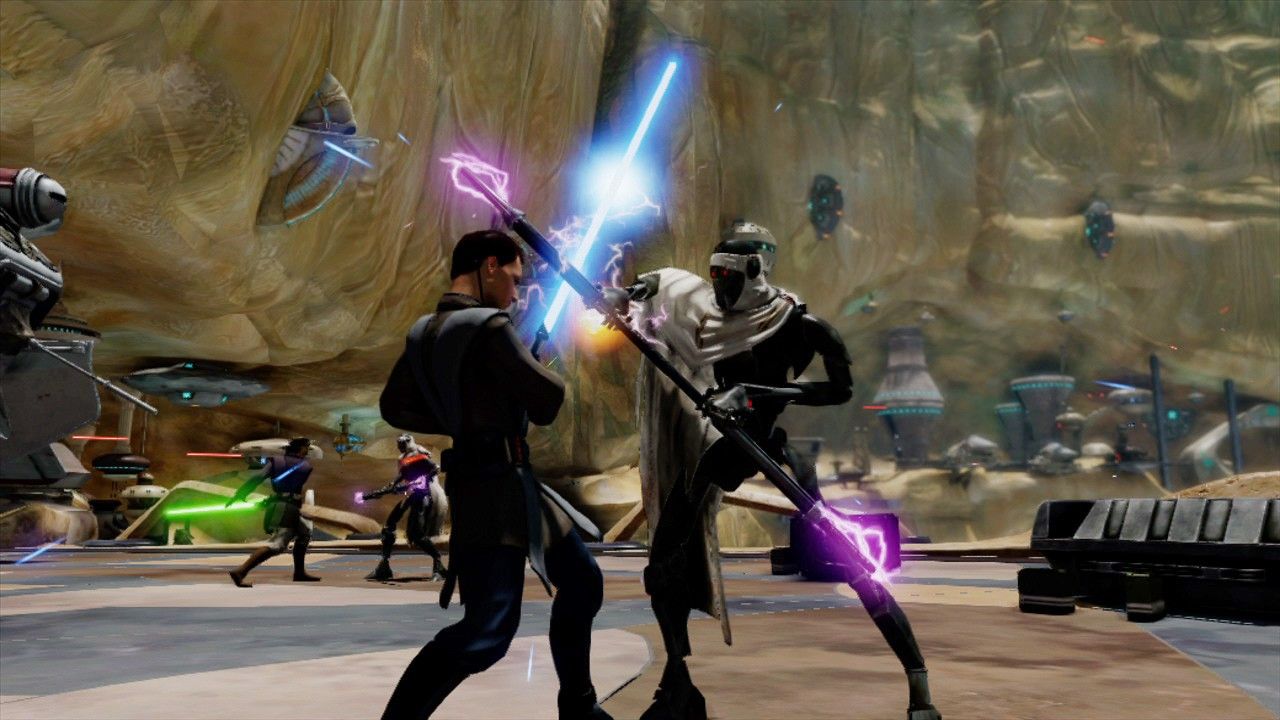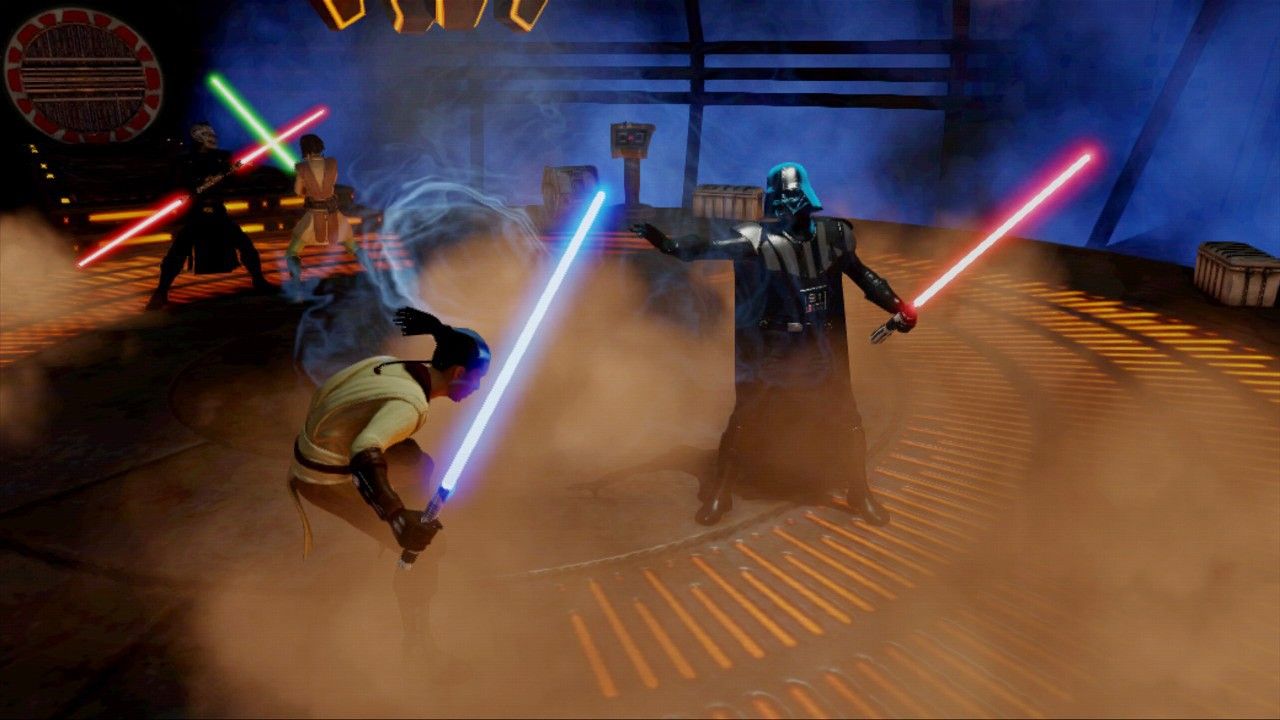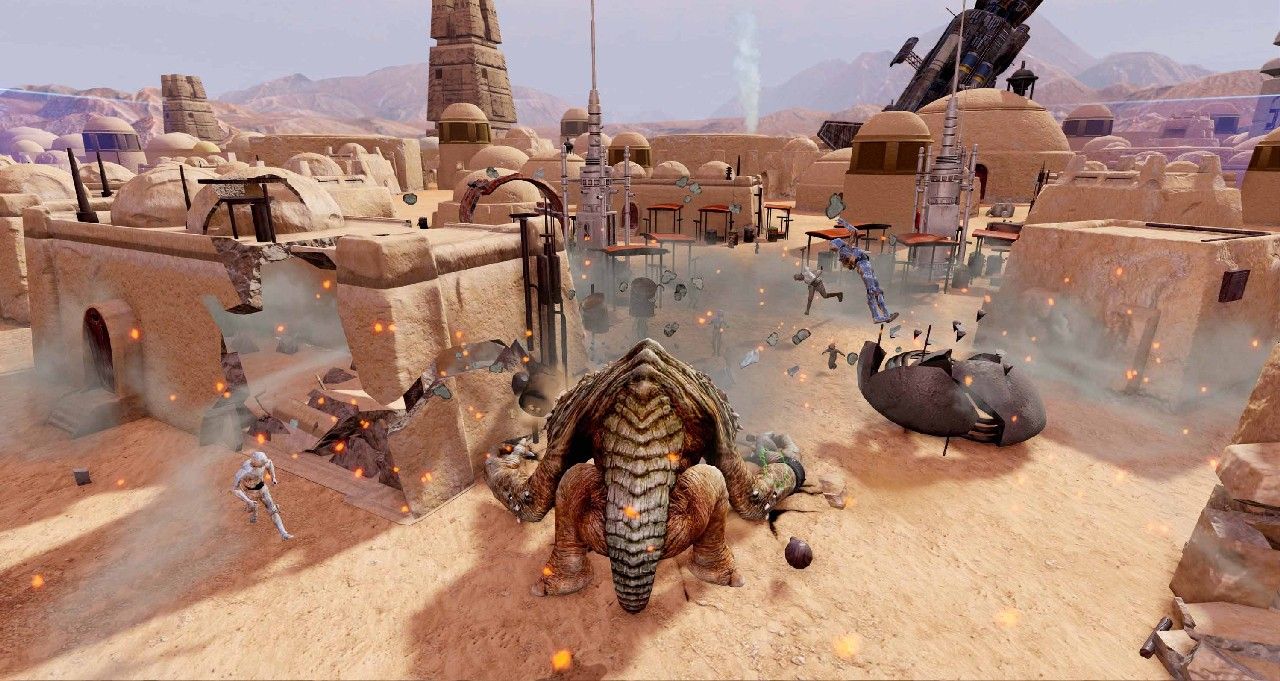Kinect Star Wars Review
Posted by
sirdesmond
on
Since motion control first made its way onto the video game scene over half a decade ago, everyone seemed to say “Think about how awesome a Star Wars game would be with that!” It seems like the perfect fit, 1:1 motion detection and the lightsaber. The result of this collective idea is Star Wars Kinect, a game that feeds that desire to wield a lightsaber in only the smallest way possible while mostly delivering an inoffensive but also non-memorable gaming experience.
Star Wars Kinect is essentially a mini-game collection. While there are fewer games with more content per game, the end result is the same. The game features Jedi Destiny, Rancor Rampage, Podracing, Galactic Dance-Off and Duels of Fate. Jedi Destiny is a third-person action game that puts you (and another player if desired) into the role of a rookie Jedi warrior on a number of missions across various planets, in space, and on speeder bikes. Rancor Rampage puts you in the unshackled feet of an escaped rancor loose on a number of locations tasked with destroying as much property and eating as many people as quickly as possible. Podracing is, just that, podracing. It will rekindle fond memories of Episode One: Podracer and then quickly make your arms so tired you’d wish they’d fall off.

Galactic Dance-Off is a Dance Central clone featuring a number of songs that have had their lyrics altered to include references to the franchise. This mode is such a clone that moves seem to have been directly stripped from Dance Central and simply renamed something Star-Wars themed. Finally, there is Duels of Fate which is a dueling mechanic featured in the Jedi Destiny mode that has been boiled down to an exhibition match/time trial challenge. All of these modes can be played in some multiplayer capacity.
Jedi Destiny seems to be where the brunt of the game’s content is included. This mode features three missions across a number of different locations each taking around an hour or more to complete, depending on the difficulty. You’ll be put through a very lengthy tutorial that will teach you every possible action (things like swinging your lightsaber, jumping, force pushing, rushing forward, etc.) but doesn’t give you a chance to properly practice some of the more advance maneuvers (like deflecting a blaster shot back at the enemy that fired it). Thankfully though, I never found myself needing to utilize any of those very few, advanced maneuvers I just mentioned. 90% of this mode can be played and completed by simply wiggling your arms from side to side and stepping back and forth, occasionally jumping in order to hop over an armored enemy’s head to attack his backside.
The other 10% are uninspired space shooter levels that play like a much more simplistic version of The Old Republic’s take on space flight. Both arms are held in front of yourself and you pantomime aiming the guns on a ship so close to the Millennium Falcon that it should have been the Millennium Falcon. The gun fires on its own. It is the simplest of target shooting in which you can seemingly shoot as many or as few of the targets on screen and get just as far (taking as many shots as you’d like) until, at certain moments, when missing one specific ship, missile, or visual cue will destroy you instantly, requiring you to re-do everything you’ve played in that segment of the mission so far. This jarring change in “difficulty” is extremely frustrating; especially during the mode’s many scenes that are little more than Dragon’s Lair-esque quicktime frenzies requiring you to hit every dodge and duck properly or face instant death.
Jedi Destiny’s most rewarding and fun to play moments are the extremely few and far between duels that your character gets into with various melee weapon and lightsaber-wielding foes. This was the only moment in my experience when I felt even the slightest hint of how cool it would be to wield a lightsaber, but even this is bogged down with overly simple mechanics. You block a number of the enemy’s extremely slow attacks then you enter a saber-clash with them where you are forced to kick, headbutt, or force push them. Only one action will work each time, although it’s seemingly random as you are given no notice on which action will work (visual cues, on-screen guidance, etc.) nor are you punished in any meaningful way for doing the incorrect action. After that, you are commanded by an onscreen prompt to attack the enemy. This process repeats until you win. Like most things in Star Wars Kinect, it fails to be bad or good, instead just sticking for the realm of “okay.”

The game’s other modes are just as “okay,” if not more so. Rancor Rampage is a fun way to thrash about for a few minutes but its leveling system, unlockables, and leaderboards seem out of place for a mode that features so little depth or ways to improve. Podracing requires you to hold your arms out in front of you, controlling one engine with each hand. It works well enough but the tracks and number of laps per track are so long (and the gameplay so simplistic) that I found my arms growing very tired before the end of the first lap. By the time I finished the race (after a little over 8 minutes), I didn’t want to continue playing the mode at all. While Galactic Dance-Off is certainly upsetting from a canonical and respect-for-the-franchise perspective, in practice it is a lackluster dance game clone that isn’t as fun as alternatives like Just Dance 3 or as good of an experience as Dance Central.
Graphically, Star Wars Kinect is a bit of a mixed bag. A vast number of studios had their hands in the development of this game, and it shows. Going from mode to mode, I noticed a certain amount of graphical disparity. Jedi Destiny boasted the strongest graphics overall, which makes sense considering it is the game’s primary game mode. Even at its best though, Star Wars Kinect isn’t going to be winning any graphical achievement awards. If I had to come up with one word to describe the game’s overall presentation it would be “fine.” Nothing all that bad, but nothing special either.
The most annoying aspects of Star Wars Kinect come with its visual glitches and inability to properly recognize the player and tie the game to their account (including achievements). The game’s visual glitches include a number of occasional camera issues, mostly during cutscenes, which will have you looking through the bottom of the level or staring straight at a wall for several seconds. While I have never personally experienced this problem with any other game, Star Wars Kinect seemed entirely unable to recognize me and log into my profile automatically. I was required to pause the game at the beginning of each level, menu, or event section of a level at times and then manually log into my account in order to properly receive things like achievements, be listed on leaderboards, etc. This led to me missing out on a number of achievements I should have received as well as properly being integrated into the game’s leaderboards, records, and leveling systems.

Star Wars Kinect isn’t a horrific game and I’m sure that the franchise has had considerably more terrible games in the past. That said, it also isn’t a good game by any stretch of the imagination. As such, I came off feeling entirely indifferent to it overall, but certainly not wanting to participate in its overly-long and limb-tiring game modes that require little more from me than simply quivering in place and moving my feet a bit. Star Wars Kinect’s biggest issue though is the fact that it fails to properly replicate any of the memorable moments from any of the films, instead deciding to create new characters and events which only feature a small number of franchise characters and, even then, only in cutscenes. As a romp through the franchise similar to Resident Evil: Umbrella Chronicles, Star Wars Kinect could have been gimmicky fun, but as something this generic and forgettable, it fails to be much of anything at all.
